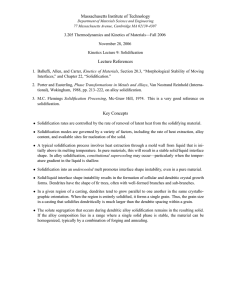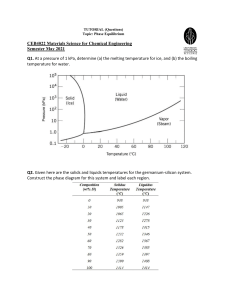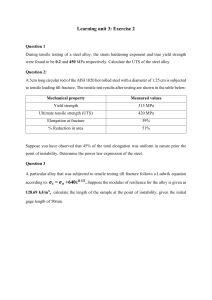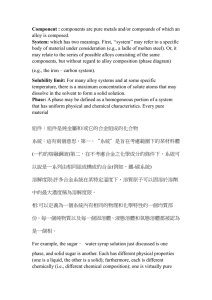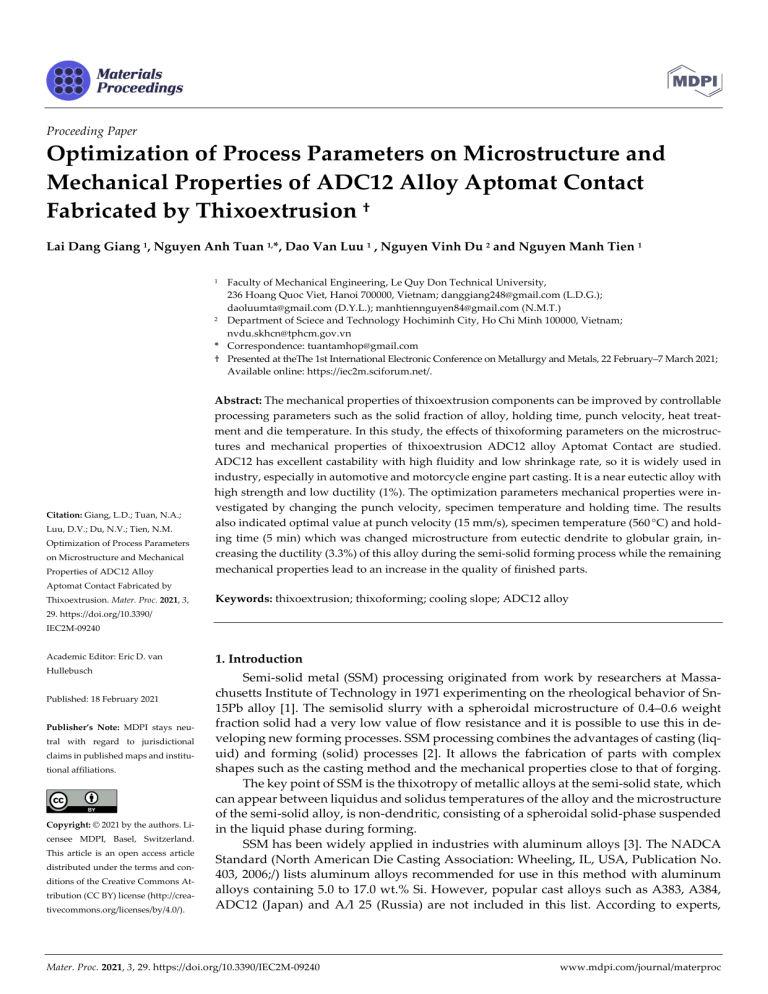
Proceeding Paper Optimization of Process Parameters on Microstructure and Mechanical Properties of ADC12 Alloy Aptomat Contact Fabricated by Thixoextrusion † Lai Dang Giang 1, Nguyen Anh Tuan 1,*, Dao Van Luu 1 , Nguyen Vinh Du 2 and Nguyen Manh Tien 1 Faculty of Mechanical Engineering, Le Quy Don Technical University, 236 Hoang Quoc Viet, Hanoi 700000, Vietnam; danggiang248@gmail.com (L.D.G.); daoluumta@gmail.com (D.Y.L.); manhtiennguyen84@gmail.com (N.M.T.) 2 Department of Sciece and Technology Hochiminh City, Ho Chi Minh 100000, Vietnam; nvdu.skhcn@tphcm.gov.vn * Correspondence: tuantamhop@gmail.com † Presented at theThe 1st International Electronic Conference on Metallurgy and Metals, 22 February–7 March 2021; Available online: https://iec2m.sciforum.net/. 1 Citation: Giang, L.D.; Tuan, N.A.; Luu, D.V.; Du, N.V.; Tien, N.M. Optimization of Process Parameters on Microstructure and Mechanical Properties of ADC12 Alloy Abstract: The mechanical properties of thixoextrusion components can be improved by controllable processing parameters such as the solid fraction of alloy, holding time, punch velocity, heat treatment and die temperature. In this study, the effects of thixoforming parameters on the microstructures and mechanical properties of thixoextrusion ADC12 alloy Aptomat Contact are studied. ADC12 has excellent castability with high fluidity and low shrinkage rate, so it is widely used in industry, especially in automotive and motorcycle engine part casting. It is a near eutectic alloy with high strength and low ductility (1%). The optimization parameters mechanical properties were investigated by changing the punch velocity, specimen temperature and holding time. The results also indicated optimal value at punch velocity (15 mm/s), specimen temperature (560 °C) and holding time (5 min) which was changed microstructure from eutectic dendrite to globular grain, increasing the ductility (3.3%) of this alloy during the semi-solid forming process while the remaining mechanical properties lead to an increase in the quality of finished parts. Aptomat Contact Fabricated by Thixoextrusion. Mater. Proc. 2021, 3, Keywords: thixoextrusion; thixoforming; cooling slope; ADC12 alloy 29. https://doi.org/10.3390/ IEC2M-09240 Academic Editor: Eric D. van Hullebusch Published: 18 February 2021 Publisher’s Note: MDPI stays neutral with regard to jurisdictional claims in published maps and institutional affiliations. Copyright: © 2021 by the authors. Licensee MDPI, Basel, Switzerland. This article is an open access article distributed under the terms and conditions of the Creative Commons Attribution (CC BY) license (http://creativecommons.org/licenses/by/4.0/). 1. Introduction Semi-solid metal (SSM) processing originated from work by researchers at Massachusetts Institute of Technology in 1971 experimenting on the rheological behavior of Sn15Pb alloy [1]. The semisolid slurry with a spheroidal microstructure of 0.4–0.6 weight fraction solid had a very low value of flow resistance and it is possible to use this in developing new forming processes. SSM processing combines the advantages of casting (liquid) and forming (solid) processes [2]. It allows the fabrication of parts with complex shapes such as the casting method and the mechanical properties close to that of forging. The key point of SSM is the thixotropy of metallic alloys at the semi-solid state, which can appear between liquidus and solidus temperatures of the alloy and the microstructure of the semi-solid alloy, is non-dendritic, consisting of a spheroidal solid-phase suspended in the liquid phase during forming. SSM has been widely applied in industries with aluminum alloys [3]. The NADCA Standard (North American Die Casting Association: Wheeling, IL, USA, Publication No. 403, 2006;/) lists aluminum alloys recommended for use in this method with aluminum alloys containing 5.0 to 17.0 wt.% Si. However, popular cast alloys such as A383, A384, ADC12 (Japan) and AЛ 25 (Russia) are not included in this list. According to experts, Mater. Proc. 2021, 3, 29. https://doi.org/10.3390/IEC2M-09240 www.mdpi.com/journal/materproc Mater. Proc. 2021, 3, 29 2 of 10 aluminum alloys with 11–13 wt.% Si content cannot form the required structure in the process of thixoforming, therefore, they are not recommended for use [4]. ADC12 has excellent cast ability with high fluidity and low shrinkage rate, so it is widely used in industry, especially in automotive and motorcycle piston casting. ADC12 (Si 12%wt) is an eutectic alloy with a eutectic dendrite microstructure which has high strength, high thermal stability and low ductility (about 1%) [5,6]. Few investigators have attempted to modify the cast structure of ADC12 alloy using near-liquidus squeeze casting (NLSC) [7], strain-induced metal activation (SIMA) [8] and Yb, samarium addition [9,10]. In this study, the cooling slope method was used to change the eutectic dendrite to equiaxed dendrites microstructure , to obtain a spherical microstructure upon semi-solid temperature reheating for thixoforming. ADC12 with globular microstructure increases the ductility of this alloy during the semi-solid forming process while the remaining mechanical properties lead to an increase in the quality of finished parts such as the piston or Aptomat Contact, increasing the reliability of the finished part. In this paper, the semi-solid die has been fabricated to serve the optimization of parameters of press temperature, holding time and velocity of the punch to the strength and elongation of Aptomat Contact, thereby studying the effects of these processing parameters on the thixoextrusion. 2. Materials and Methods 2.1. Materials Chemical compositions of Aluminum ADC12 alloy were determined by Spectrolab machine in Laboratory of Institute of Technology, presented in Table 1. It is worth noting that the silicon content was 11.6% (eutectic alloy) and 2% Cu. This metal was added to increase the strength and machinability. It also reduces the slope of the cooling curve and creates a semi-solid temperature range for the eutectic alloys [11]. The DSC (differential scanning calorimetry) method has been used to accurately determine the semi-solid window temperature range for this alloy. This is the method commonly used to determine the material transition temperature as shown in Figure 1. Cube 2 mm3 reheated to 700 °C with a cooling rate 10 °C/min and then cooled with the same velocity in DSC 2500 at the physics department in Le Quy Don University. The result shows that the melting and solidus temperature of ADC12 are 574 °C and 500 °C respectively (Figure 1a). Based on the cooling curve, it can be determined that the suitable semisolid machining temperature for ADC12 is 560–566 °C (Figure 1b). Machining temperature is a very important value that directly affects the liquid phase fraction of the billet in the forming process, which determines the integrity of the part. a) T, oC 620 T, oC b) 620 exo 600 600 571,7 oC 580 580 560 560 540 540 520 520 500 500 Temp for thixoforming 480 480 DSC, (mW/mg) -0.6 -1.2 -1.8 -2.4 -3.0 t (h) Mater. Proc. 2021, 3, 29 3 of 10 Figure 1. Differential scanning calorimetry (DSC) curve of ADC12 aluminum alloy: (a) DSC curve of ADC12 Al alloy during heating; (b) Change in solid fraction as a function of temperature for the ADC12 Al alloy. Table 1. Chemical composition of ADC12 alloy. Element Si wt% 11.58 Fe 0.63 Cu 2.09 Mn 0.17 Mg Cr Ni 0.081 0.023 0.055 Zn 0.77 Ti Pb 0.048 0.056 Al 84.5 2.2. Preparation of Billet To create a billet for the semi-solid forming process a scheme of a cooling slope casting was built (Figure 2a). The billet creation process for the cooling slope was conducted as follows: 1100 g aluminum alloy was put in a graphite crucible and melted by an Nabertherm electric resistance furnace at 700 °C and then cooled to pouring temperature. The melting alloy was poured onto the surface of cooling slope plate made of stainless steel with a water-circulating cooling. The semi-solid slurry was collected from the cooling slope into a stainless steel mold. The mold was placed in a furnace to keep the temperature at 300 °C within 5 min, then quenched in water. Type K thermocouple were placed at different locations of the cooling slope to measure the temperature. The billet obtained from the casting process is shown in Figure 2b. (a) (b) Figure 2. Scheme of cooling slope casting: (a) Schematic diagram of cooling slope casting; (b) billet after casting. 2.3. Organization of Experiment and Sample Analysis The casting billet was cut into pieces with dimensions Φ50 × 20 (Figure 3b), then heated by resistance furnace to a specified temperature. To accurately control the temperature of the billet, type K thermocouple was inserted in the center of the billet (Figure 3a), as the billet achieved a semi-solid state that was pressed into the mold cavity to form the desired part (Figure 3b) by a 100 ton hydraulic press. Factors investigated during the process consisted of three input parameters: the workpiece temperature selected at 560 and 566 °C and denoted by x1, the holding time selected at 5 and 15 min denoted by x2 and the punch velocity selected at 3 and 15 mm/s denoted by x3. Their values are shown in Table 2. Two response values of the study, ultimate tensile strength and elongation, were determined by cutting and tensile testing on Mater. Proc. 2021, 3, 29 4 of 10 MST Landmark 810 as shown in Figure 4. To improve the accuracy of the obtained regression function, the study conducted central experiments with three repeating experiments denoted as 0 in Table 3. Resistance furnace Sensor hold Billet Base Unit: mm (a) (b) Figure 3. The experiment model, billets and products. (a) The experiment model; (b) billets before forming and products. Table 2. Factors and level of the input value in the experiment. Symbol Factor Unit x1 x2 x3 Specimen temperature Holding time Punch velocity °C min mm/s (a) Processing Parameter −1 1 560 566 5 15 3 15 (b) Figure 4. Schemes of cooling slope casting: (a) Schematic diagram of cooling slope casting; (b) billet after casting. Table 3. Experimental results. Factor 1 Std 1 Run 11 Factor 2 B:Holding A:Specimen Temp Time °C min −1 −1 Factor 3 C:Punch Velocity mm/s −1 Response 1 Response 2 UTS Elongation MPa 304 δ, % 3 Mater. Proc. 2021, 3, 29 5 of 10 2 3 4 5 6 7 8 9 10 11 5 9 4 8 6 2 3 10 1 7 1 −1 1 −1 1 −1 1 0 0 0 −1 1 1 −1 −1 1 1 0 0 0 −1 −1 −1 1 1 1 1 0 0 0 248 287 277 311 254 305 285 288 287 285 2 2.3 2.5 3.3 1.6 3.2 2.3 2.4 2.3 2.4 3. Results and Discussion 3.1. Comparison of the Microstructure between Cooling Slope Casting and Thixoextrusion Figure 5a shows the microstructure of the ADC12 alloy that was cast at a pouring temperature of 580 °C without using the cooling slope. The slope length, slope angle and slope temperature used were 300 mm, 65° and room temperature, respectively. The bright phase is primary α-Al phase, and the grey phase surrounding the bight phases is Si eutectic phase. It was observed that a large number of fine primary globular α-Al grains formed by the cooling slope casting and uniform cooling were parallel to dendrites fragmentation and spheroidization during the casting process (Figure 5a). This can be explained as follows; grains nucleated on plate of slope along with the detached nuclei grow during movement from the top to the bottom of the cooling slope [3]. Most of the nucleation that has occurred at the top of the cooling slope may be considered as a general source of nuclei. (a) (b) Figure 5. Comparison of the microstructure of cooling slope casting and thixoextrusion: (a) Microstructure of cooling slope casting; (b) microstructure of thixoextrusion. As shown in Figure 5b, the microstructure obtained after thixoextrusion has a globular microstructure of primary α-Al, the research has created a uniform globular microstructure in the finished parts. This is one of the reasons to improve the strength and elongation of this parts [12]. This phenomenon can be explained as follows; after heating the billet to a semi-solid state, the diffusion process takes place strongly at high temperatures, combined with the Ostwald ripening phenomenon to help globular the aluminum grains. 3.2. Comparison of Mechaniacal Properties between Die Casting and Thixoextrusion Table 4 presents the results of measuring the properties of a thixoextrusion “Aptomat Contact” from ADC12 alloy. Reference data were taken from the publication. The appearance of thixoformed products and the scheme for cutting out the test specimens are shown in Figure 4, The microstructure of the part is shown in Figure 5b. The results showed that Mater. Proc. 2021, 3, 29 6 of 10 there is a significant increase in the strength and elongation of the parts formed by the semi-solid processing method. Mater. Proc. 2021, 3, 29 7 of 10 Table 4. Mechanical properties of ADC12 alloy and equivalence. Item No. 1 2 3 4 Manufacturing Technology, Alloy ADC12 and Equivalence Die casting [13] AЛ25 Die casting [14] AЛ25 Liquid forming (P = 150 MPa) [14] Thixoextrusion part Mechanical Properties UTS, MPa 0.2% YS, MPa 228 154 220 220 250 240 283 251 δ, % 1.4 0.5 0.85 2.5 3.3. Results of Experiments Thixoextrusion is accepted by many manufacturing industries. In order to design experimental work, three processing parameters, namely specimen temperature, holding time and punch velocity, were chosen as input variables whereas ultimate tensile strength and elongation obtained from the tensile test were recorded as responses. A series of trial experiments were carried out to find the limit of input variables. Limits of variables were notified as −1, 0 and +1 for the lower value, middle value and higher value, respectively, while input variables were notified as A for specimen temperature (C), B for holding time (min) and C for punch velocity (mm/s). There were 11 test trials performed based on the design on the experiment method, as shown in Table 3. 3.4. Optimization of Ultimate Tensile Strength and Elongation for the Productions ANOVA analysis was used to determine the adequacy and significance of the model, and to evaluate the effect of lack of fit on model and significance of individual model coefficient. Selecting stepwise backward disqualification method to superannuate the insignificant term from the model, the result of ANOVA for the ultimate tensile strength (UTS) and elongation are described in Tables 5 and 6, respectively. The values of f are 92.53 and 27.38 for UTS and elongation, respectively, indicating that the model is very significant. There is only a 0.01% chance that an F-value of this magnitude could occur due to noise. There is 0.07% value of F that is probable for interference for elongation, and for UTS it is 0.01%. In both models, the effect of the specimen temperature accounts for a significant value. In the UTS model, the effect of temperature is 65.6%, while in the elongation model this value is 56.1%. In the UTS model, the effects of the holding time and punch velocity are at equilibrium (less than 5%), while in the elongation model these two variables do not appear. In these models, the value of the coefficient of determination R2 and Adjusted R2 are both greater than or equal to 90%, which shows that the found models are statistically significant (R2 = 0.98 means 98% of the total variability observed in this model. Adeq Precision measures the signal-to-noise ratio. A ratio greater than 4 indicates an adequate signal [15]). The following equations are the final empirical models in terms of coded factors for UTS and the elongation: UTS = 283.88 − 17.87 * A + 4.63 * B + 4.88 * C + 10.38 * AB (1) Elongation = 2.53 − 0.425 * A + 0.25 * AB − 0.225 * AC (2) Mater. Proc. 2021, 3, 29 8 of 10 Table 5. ANOVA for ultimate tensile strength. Source Model A-Specimen temp B-Holding time C-Punch velocity AB Curvature Residual Lack of Fit Pure Error Cor Total R2 Adjusted R2 Predicted R2 Adeq Precision Sum of Squares 3778.50 2556.12 171.13 190.13 861.13 17.00 51.04 46.37 4.67 3846.55 0.9867 0.9760 0.9111 28.0756 df 4 1 1 1 1 1 5 3 2 10 Mean Square 944.63 2556.12 171.13 190.13 861.13 17.00 10.21 15.46 2.33 F-Value p-Value %Contribution 92.53 250.40 16.76 18.62 84.36 1.67 <0.0001 <0.0001 0.0094 0.0076 0.0003 0.2533 significant 66.5% 4.4% 4.9% 22.4% 6.62 0.1340 not significant Table 6. ANOVA for elongation. Source Model A-Specimen temp AB AC Curvature Residual Lack of Fit Pure Error Cor Total R2 Adjusted R2 Predicted R2 Adeq Precision Sum of Squares 2.35 1.44 0.5000 0.4050 0.0547 0.1717 0.1650 0.0067 2.58 0.9319 0.8979 0.7323 15.7840 df 3 1 1 1 1 6 4 2 10 Mean F-Value p-Value Square 0.7833 27.38 0.0007 1.44 50.50 0.0004 0.5000 17.48 0.0058 0.4050 14.16 0.0094 0.0547 1.91 0.2160 0.0286 0.0413 12.37 0.0762 0.0033 %Contribution significant 56.1% 19.4% 15.7% not significant 3.5. Effect of Processing Parameters on the Ultimate Tensile Strength and Elongation The influence of the processing parameters on the UTS and elongation of the part is shown in Figure 6. As analyzed in Section 3.4, specimen temperature is the parameter that has the greatest influence on these two output factors. The steady rise in specimen temperature reduces the strength and elongation of finished parts because the specimen temperature directly affects the liquid phase fraction of the billets. If the temperature is too low, it is difficult to form. If the temperature is too high, the workpiece cannot remain semi-solid state and flow like a liquid . The influence of the other two variables is smaller and fairly balanced. Increasing the holding time reduces the strength and elongation while the punch velocity has the opposite effect. Mater. Proc. 2021, 3, 29 9 of 10 Figure 6. Effect of processing parameters on the ultimate strength and elongation. 4. Optimization of Parameters Desirability function optimization of regression function has been utilized for all outputs. For the optimization process, the main objective was to find out the optimal values of processing condition in order to maximize the value of the UTS and elongation during the thixoextrusion. Optimal values can be seen in Table 7 as follows for specimen temperature (560 °C) holding time (5 min) and punch speed (15 mm/s). Table 7. Optimization solution. No. 1 2 3 Specimen Temp 560.068 560.109 560.012 Holding Time 5.151 5.055 5.288 Punch Velocity 14.833 14.844 14.338 UTS 311.437 311.163 311.392 Elongation Desirability 3.391 3.384 3.382 1.000 1.000 1.000 Selected 5. Conclusions This study discusses the application design of the experiment to investigate the effects of semi-solid metal process parameters on the UTS and elongation of Aptomat Contact made from ADC12 alloy. The following main conclusions are drawn from this study: 1. 2. 3. Aptomat Contact formed by semi-solid metal process with ADC12 alloy. This is an alloy not recommended for use in this forming method, and the appropriate forming temperature range for ADC12 alloy is 560–566°C Creating a uniform globular microstructure in the semi-solid metal process helps improve the mechanical properties of the finished part. The coefficient of determination of the developed regression models for UTS and the elongation are 0.98 and 0.93, respectively, confirming the effectiveness of the developed regression models. Mater. Proc. 2021, 3, 29 10 of 10 Author Contributions: Conceptualization, L.D., D.V. and N.A.; methodology, L.D. and N.A.; software, L.D. and N.A; validation, N.A., D.V., N.V. and N.M.; formal analysis, N.A.; investigation, L.D. and N.A.; resources, N.A.; data curation, N.A.; writing—original draft preparation, N.A.; writing— review and editing, N.A. All authors have read and agreed to the published version of the manuscript. Funding: This research received no external funding Conflicts of Interest: The authors declare no conflict of interest References 1. 2. 3. 4. 5. 6. 7. 8. 9. 10. 11. 12. 13. 14. 15. Fan, Z. Semisolid metal processing. Int. Mater. Rev. 2013, 47, 49–85, doi:10.1179/095066001225001076. Koeune, R.; Ponthot, J.P. A one phase thermomechanical model for the numerical simulation of semi-solid material behavior. Application to thixoforming. Int. J. Plast. 2014, 58,120–153, doi:10.1016/j.ijplas.2014.01.004. Nafisi, S.; Ghomashchi, R. Semi-Solid Processing of Aluminum Alloys; Springer: Berlin, Germany, 2016. Ngo, T.B.; Semenov, A.B.; Semenov, B.I. Thixoforming of Wrought Aluminum Alloy 1973. Solid State Phenom. 2019, 285, 203– 209, doi:10.4028/www.scientific.net/SSP.285.203. Barrirero, J. Eutectic Modification of Al-Si Casting Alloys; Linköping University Electronic Press: Linköping, Sweden, 2019. Vinith, S.; Uthayakumar, A.; Rajan, S. Fluidity of ADC12 alloy based on theoretical and computational fluid dynamics. Mech. Eng. 2015, 4, 996–999. Wang, S.; Ji, Ze.; Sugiyama, S.; Yanagimoto, J. Formation and Growth Mechanism of Globular Crystal of ADC12 Aluminum Alloy by Near-Liquidus Squeeze Casting. Adv. Mech. Eng. 2015, 6, doi:10.1155/2014/358754. Wang, Z.; Ji, Z.; Hu, M.; Xu, H. Evolution of the semi-solid microstructure of ADC12 alloy in a modified SIMA process. Mater. Charact. 2011, 62, 925–930, doi:10.1016/j.matchar.2011.07.003. Rao, Y.; Yan, H.; Hu, Z. Modification of eutectic silicon and β-Al5FeSi phases in as-cast ADC12 alloys by using samarium addition. J. Rare Earths 2013, 31, 916–922, doi:10.1016/s1002-0721(12)60379-2. Xiong, J.; Yan, H.; Zhong, S.; Bi, M. Effects of Yb Addition on the Microstructure and Mechanical Properties of As-Cast ADC12 Alloy. Metals 2019, 9, 108, doi:10.3390/met9010108. Liu, D.; Atkinson, H.V.; Jones, H. Thermodynamic prediction of thixoformability in alloys based on the Al–Si–Cu and Al–Si– Cu–Mg systems. Acta Mater. 2005, 53, 3807–3819, doi:10.1016/j.actamat.2005.04.028. Pola, A.; Tocci, M.; Kapranos, P. Microstructure and Properties of Semi-Solid Aluminum Alloys: A Literature Review. Metals 2018, 8, 181, doi:10.3390/met8030181. Japanese Industrial Standard, Aluminum Alloys Die Castings (ADC 12), JIS H 5302:Japan; Japanese Industrial Standard: Tokyo, Japan, 2000; p. 10. Semenov, A.B.; Ngo, T.B.; Semenov, B.I. Thixoforming of Hypereutectic AlSi12Cu2NiMg Automotive Pistons. Solid State Phenom. 2019, 285, 446–452, doi:10.4028/www.scientific.net/SSP.285.446. Paskevich, A.; Wies, T. Verified Software. Theories, Tools, and Experiments. In Proceedings of the 9th International Conference, VSTTE 2017, Heidelberg, Germany, 22–23 July 2017; Volume 10712. Revised Selected Papers.
